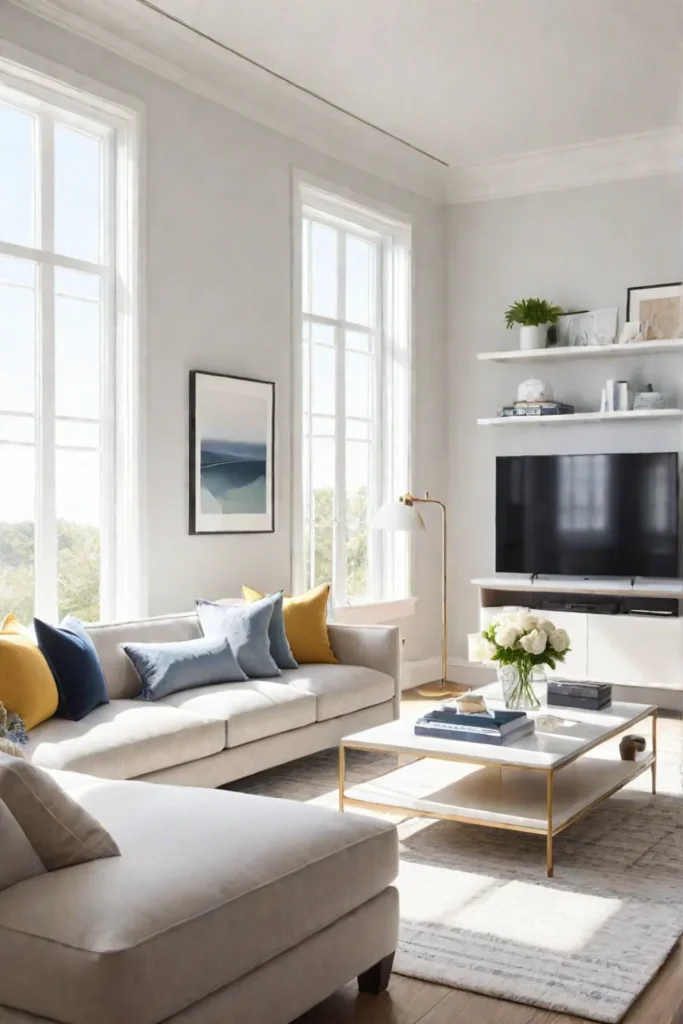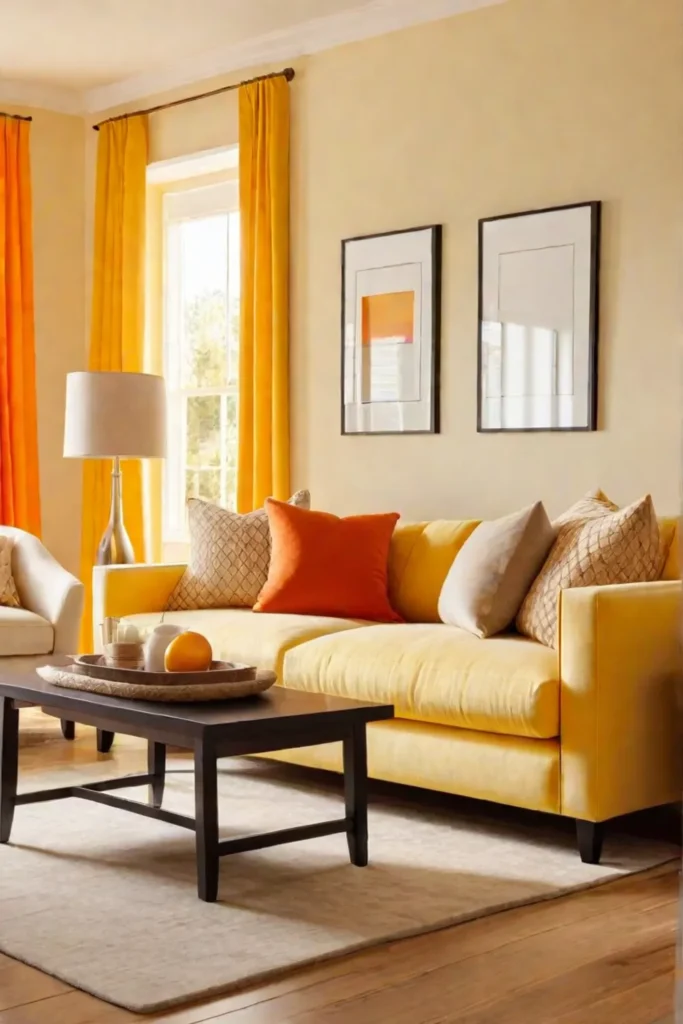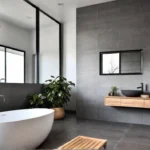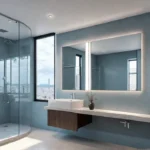Color has the power to transform spaces and evoke profound emotions within us. As an intrepid world traveler passionate about infusing global aesthetics into every corner of my home, I’ve learned that mastering the art of color is the key to creating a living room that captures the essence of wanderlust.
From the vibrant spice markets of Marrakech to the serene beaches of Bali, I’ve witnessed firsthand how different cultures wield color to shape moods and experiences. Now, I’m here to share those insights and guide you through the captivating world of color psychology, empowering you to craft a living room that resonates with your unique style and transports you to the farthest reaches of your imagination.

Whether you crave the invigorating energy of warm, sunbaked terracotta or the tranquil embrace of cool ocean blue, this exploration will unveil the secrets to harmonizing hues, balancing bold statements with timeless design principles, and ultimately curating a space that is an extension of your personal journey.
So, let’s embark on this chromatic adventure together, where every brushstroke and color swatch promises to transform your living room into a soul-stirring sanctuary that celebrates the beauty of the world around us.
Understanding the Impact of Color
Colors powerfully impact the mood and atmosphere of any room or garden. Each color triggers specific emotional and psychological responses influenced by cultural context and individual experiences.
The Psychology of Warm Colors
Warm colors like red, orange, and yellow exude energy and vibrancy. Red, for instance, can increase heart rate and stimulate appetite – perfect for creating a lively and inviting living room atmosphere. Orange radiates warmth and happiness, while yellow evokes joy and optimism.

The Psychology of Cool Colors
On the other hand, cool colors like blue, green, and purple tend to have a calming and serene effect. Blue, often associated with the sky and ocean, promotes relaxation and tranquility. Green connects us with nature and can create a refreshing, rejuvenating environment. With its regal undertones, purple can add a touch of luxury and sophistication.
Individual Preferences and Cultural Symbolism
It’s important to note that color preferences are highly personal and can be influenced by individual personality traits and cultural backgrounds. For instance, some cultures associate certain colors with specific meanings or symbolism that may differ.
To create the desired mood in your living room, consider using warm colors like red and orange to foster a vibrant and energetic atmosphere. Alternatively, choose cool colors like blue and green to cultivate a relaxing and tranquil ambiance.

Remember, the impact of color is profound, so choose hues that resonate with your desired mood and atmosphere. With the right color palette, you can transform your living room into a space that uplifts your spirits or provides a serene escape from the day’s hustle and bustle.
Creating a harmonious and cohesive color palette is the next step in setting the mood with living room hues.
Creating Moods with Color Palettes
Color palettes play a crucial role in defining the atmosphere and style of a living room. Carefully chosen color combinations can create specific moods, transforming the space into a cozy sanctuary or a refreshing oasis.

Warm and Inviting Palettes
Consider a palette of rich reds, vibrant oranges, and sunny yellows if you aim for a warm and inviting atmosphere. These hues radiate energy and warmth, creating a cozy, welcoming ambiance perfect for gathering with loved ones. Imagine snuggling up on a plush sofa surrounded by warm terracotta walls and accents of golden yellow – pure comfort!
Cool and Calming Palettes
On the other hand, if you’re seeking a serene and calming space to unwind after a long day, a cool palette of blues, greens, and purples might be just what you need. These soothing hues naturally relax, evoking a sense of tranquility and peace. Picture yourself lounging in a living room adorned with soft blue-gray walls and pops of fresh green – a true oasis of serenity.
Neutral and Balanced Palettes
For those who prefer a more versatile and balanced approach, a neutral palette of whites, grays, and beiges can be a fantastic choice. These timeless hues create a clean and sophisticated canvas, allowing you to experiment with pops of color through accent pieces and accessories. A living room with warm taupe walls and crisp white trim exudes an understated elegance, perfect for any style or mood.

Different color combinations can evoke various emotional responses, from energizing and invigorating to calming and soothing. When it comes to creating balanced color palettes, it’s all about finding the right harmony and contrast. Monochromatic palettes, which use variations of a single color, develop a sense of unity and cohesion. Complementary palettes, using colors opposite each other on the color wheel, create a vibrant and dynamic contrast. And analogous palettes, using colors adjacent to each other on the color wheel, offer a more subtle and harmonious blend.
The key takeaway is to choose a color palette that aligns with the desired mood and style you envision for your living room. Don’t be afraid to experiment with different color combinations until you find the perfect match for your space and personal preferences.
Harmonizing Color with Furniture and Decor
Harmonizing colors is crucial for creating a cohesive, stylish living room that reflects your taste.

Matching Colors with Furniture Styles
When selecting wall colors, it’s crucial to consider the colors of your existing furniture and decor. For instance, if you have a modern living room with neutral-toned furniture, you could create a bold statement by painting an accent wall in a vibrant shade like emerald green or mustard yellow. On the other hand, if you have a traditional living room with dark wood furniture, light and airy wall colors like soft blues or creams can create a beautiful contrast and prevent the space from feeling too heavy.
Using Color to Highlight Architectural Features
Color can also be a powerful tool for highlighting architectural features in your living room. For example, if you have a stunning fireplace or built-in shelving, painting them in a contrasting color can create a focal point and add depth to the space. Just be sure to balance it out with complementary hues throughout the room.

The 60-30-10 Rule
One of my favorite techniques for achieving color harmony is the 60-30-10 rule. This guideline suggests using 60% of a dominant color, 30% of a secondary color, and 10% of an accent color. Following this ratio can create a balanced and visually pleasing color distribution throughout the room. The accent colors can be incorporated through throw pillows, rugs, artwork, and other decorative elements, adding interest and personality to the space.
How can color be used to create focal points in a living room? By strategically using bold or contrasting colors on architectural features or accent walls, you can draw the eye to specific areas and create a sense of depth and interest.
What are effective ways to balance bold and neutral colors? One approach is to use bold colors as accents against a neutral backdrop or vice versa. You can also incorporate varying shades and tones of the same color to create a harmonious blend.

The key takeaways are to harmonize wall colors with your furniture and decor to create a cohesive design and to use color strategically to enhance the overall aesthetic of your living room.
Lighting is crucial in how colors are perceived in a space, so let’s explore that in the next section.
The Influence of Lighting on Color
lighting is crucial in home decor, greatly influencing color perception and the overall ambiance of your living room. The combination of natural and artificial light sources can dramatically alter the mood of the space.
Warm vs. Cool Lighting
One of the most fascinating aspects of lighting is the concept of color temperature. With its cozy and inviting hues, warm lighting creates a welcoming atmosphere that envelops you in a warm embrace. On the other hand, cool lighting exudes a more energetic and vibrant vibe, perfect for those seeking a refreshing and uplifting environment.

Layering Lighting for Depth and Dimension
To truly unlock the full potential of your living room’s color scheme, I recommend layering different types of lighting. Combining ambient, task, and accent lighting will create a harmonious and balanced lighting scheme that adds depth and dimension to your space. This layering technique enhances the mood and provides flexibility, allowing you to adjust the lighting to suit different occasions or activities.
Practical Tips
Here are a few practical tips to help you harness the power of lighting in your living room:
- Use warm white light bulbs in living rooms with cool-toned walls to create a sense of balance and harmony.
- Install dimmer switches to adjust lighting intensity easily and create moods from cozy and intimate to bright and energetic.
- Consider the direction and amount of natural light in your living room, and strategically place mirrors or reflective surfaces to maximize its impact.

How does lighting affect the emotional impact of color? Well, lighting can either enhance or diminish the vibrancy and depth of your chosen color scheme. The right lighting can evoke a sense of warmth, energy, or tranquility, ultimately shaping the overall mood and emotional response to your living room.
What are the best lighting practices for different living room styles? Warm lighting with dimmers is ideal for a cozy and intimate living room. For a more modern and energetic space, consider layering cool and accent lighting to create depth and visual interest.
The key takeaway is that lighting is crucial in how colors are perceived and experienced in your living room. By choosing the right lighting and strategically combining different sources, you can create a harmonious and inviting atmosphere that perfectly complements your color scheme and desired mood.

Creating personalized color choices is equally important in creating a living room that truly resonates with your personality and style preferences.
Personalizing Color Choices
Personalizing your living room’s color scheme is key to creating a space that reflects your unique style.
Creating a Reflection of Personal Style
The living room is where you spend quality time with loved ones, entertain guests, and unwind after a long day. As such, it should reflect your unique personality and tastes. When selecting colors, consider the room’s function and purpose, as well as your personal preferences. Don’t be afraid to incorporate bold hues or experiment with unexpected color combinations that speak to your style.

Balancing Trends with Timeless Design
While following the latest color trends is tempting, balancing trendy and timeless design elements is essential. Color preferences can be influenced by personality, experiences, and cultural background, so trust your instincts and choose hues that resonate with you. At the same time, incorporate timeless design elements that ensure your living room remains stylish and relevant over time.
Practical Tips for Personalizing Color Choices
To help you visualize your desired aesthetic, create a mood board with color swatches, fabric samples, and inspirational images. Incorporate personal mementos, travel souvenirs, or artwork with sentimental value to add a unique touch to your living room. Experiment with color samples and visualize the space before making a final decision.
How can individuals develop their color style? By exploring their preferences, seeking inspiration from various sources, and embracing their unique tastes and experiences. What are the key considerations for creating a timeless living room design? Balance personal expression with classic design principles, incorporate quality materials, and choose versatile, adaptable colors.

The key takeaways are personalizing color choices to create a living room that reflects individual style and preferences while balancing personal expression with design principles to create a harmonious and inviting space.
This section explored how to infuse your living room with colors that reflect your personality and create a space that truly feels like yours. In the next section, we’ll conclude our exploration of color psychology in the living room.
Conclusion
Ultimately, the true magic of color lies in its ability to transport us, evoke cherished memories, and ignite our sense of wonder. As a lifelong explorer, I’ve learned that the most captivating spaces blend wanderlust and personal expression, inviting us to embark on an endless journey of self-discovery.

By mastering the art of color psychology and harmonizing hues with your unique style, you can create a living room as a canvas for your life’s adventures. This space celebrates the richness of the world while providing a sanctuary for reflection and rejuvenation.
So, embrace the kaleidoscope of possibilities that color offers and let your living room become a vibrant tapestry woven with the threads of your experiences, dreams, and cultural explorations. When you harness the transformative power of color, every corner of your home becomes a gateway to the extraordinary, a testament to the boundless potential of the human spirit to seek, discover, and embrace the beauty surrounding us.






